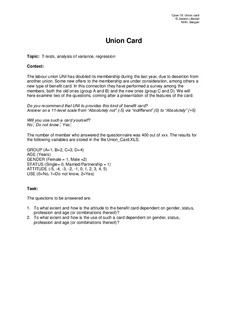| dc.description.abstract | Topic: T-tests, analysis of variance, regression
Context:
The labour union UNI has doubled its membership during the last year, due to desertion from another union. Some new offers to the membership are under consideration, among others a new type of benefit card. In this connection they have performed a survey among the members, both the old ones (group A and B) and the new ones (group C and D). We will here examine two of the questions, coming after a presentation of the features of the card:
Do you recommend that UNI to provides this kind of benefit card?
Answer on a 11-level scale from “Absolutely not” (-5) via “indifferent” (0) to “Absolutely” (+5)
Will you use such a card yourself?
No / Do not know / Yes
The number of member who answered the questionnaire was 400 out of xxx. The results for the following variables are stored in the file Union_Card.XLS:
GROUP (A=1, B=2, C=3, D=4)
AGE (Years)
GENDER (Female = 1, Male =2)
STATUS (Single= 0, Married/Partnership = 1)
ATTITUDE (-5, -4, -3, -2, -1, 0, 1, 2, 3, 4, 5)
USE (0=No, 1=Do not know, 2=Yes)
Task:
The questions to be answered are:
1. To what extent and how is the attitude to the benefit card dependent on gender, status, profession and age (or combinations thereof)?
2. To what extent and how is the use of such a card dependent on gender, status, profession and age (or combinations thereof)? | nb_NO |


